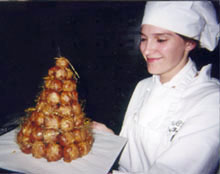Pastry: Difference between revisions
CSV import Tags: mobile edit mobile web edit |
CSV import |
||
| Line 41: | Line 41: | ||
{{food-stub}} | {{food-stub}} | ||
<gallery> | |||
File:Jean Philippe - Pastries.jpg|Pastry | |||
File:Lille Meert2.JPG|Pastry | |||
File:Pastry chef ferguson.jpg|Pastry | |||
File:BULLAR CRYSTAL.jpg|Pastry | |||
File:Croissant hk DIY.jpg|Pastry | |||
File:Baklava S.jpg|Pastry | |||
File:Piroshki.JPG|Pastry | |||
File:Foto.Linzertorte.JPG|Pastry | |||
File:Mignon14hpA3.jpg|Pastry | |||
File:Weihnachtskeks(RobertK).jpg|Pastry | |||
File:Moorkoppen.jpg|Pastry | |||
File:Feesttompoucen0865.jpg|Pastry | |||
</gallery> | |||
Latest revision as of 01:15, 20 February 2025






Pastry is a dough of flour, water and shortening (solid fats, including butter) that may be savoury or sweetened. Sweetened pastries are often described as bakers' confectionery. The word "pastries" suggests many kinds of baked products made from ingredients such as flour, sugar, milk, butter, shortening, baking powder, and eggs. Small tarts and other sweet baked products are called pastries. Common pastry dishes include pies, tarts, quiches, and pasties.
Types of Pastry[edit]
The main types of pastry are:
- Shortcrust pastry: The simplest and most common pastry. It is made with flour, fat, and water to bind the dough. This is used for tarts, pies, and quiches.
- Puff pastry: Made with several layers of fat which are folded into the dough to create a flaky, light pastry after baking. It is used for pastries like croissants, Danish pastries, and vol-au-vents.
- Choux pastry: A light pastry dough used to make éclairs, cream puffs, and profiteroles. It employs high moisture content to create steam during cooking to puff the pastry.
- Filo pastry: A very thin unleavened dough used for making pastries like baklava and börek in Middle Eastern and Balkan cuisines.
- Hot water crust pastry: A type of pastry used for savory pies, such as pork pies, game pies, and, more rarely, steak and kidney pies. Hot water crust is traditionally used for making hand-raised pies.
Ingredients[edit]
The primary ingredients in pastry making include:
- Flour: The basic structure of the pastry. Wheat flour is the most common type used.
- Fats: Including butter, lard, or vegetable shortening. Fats are incorporated into the dough to give the pastry its texture.
- Liquids: Water, milk, or eggs are used to bind the dough and affect the tenderness and flakiness of the finished product.
- Sugar: Added for sweetness and to tenderize the pastry.
- Leavening agents: Such as baking powder or yeast, may be used in some pastries to produce a lighter, airier texture.
Preparation and Techniques[edit]
Pastry making involves various techniques that affect the texture and flavor of the finished product. These include:
- Rubbing in: A method where fat is rubbed into the flour before adding any liquid to make breadcrumbs-like texture.
- Folding: Used in making puff pastry, where the dough is repeatedly folded and rolled to create layers.
- Blind baking: Pre-baking the pastry crust before adding the filling to prevent it from becoming soggy.
- Glazing: Applying egg or milk wash before baking to give the pastry a golden and glossy finish.
Cultural Significance[edit]
Pastry has a significant place in various cultures around the world, with each having its unique variations and specialties. For example, in France, pastries like croissants and éclairs are an integral part of the cuisine. In the Middle East, pastries such as baklava are traditionally served during festive occasions.
See Also[edit]
-
Pastry
-
Pastry
-
Pastry
-
Pastry
-
Pastry
-
Pastry
-
Pastry
-
Pastry
-
Pastry
-
Pastry
-
Pastry
-
Pastry












